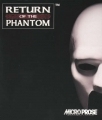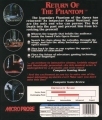Return of the Phantom
First posted on 15 January 2015. Last updated on 15 January 2015.
It is fair to say that The Phantom of the Opera is among the best-known fictional work in history. From the original novel by Gaston Leroux first published in 1910 to the many different film and musical adaptations made since then—including the wildly popular Andrew Lloyd Weber incarnation—the story and characters of The Phantom of the Opera are so ingrained into popular culture that they have arguably become folklore. To make a point-and-click adventure game based on this iconic fable may therefore seem at first to be a futile effort—after all, the source material, known so well to so many, does not leave much (wiggle) room for story expansion and puzzle integration in a game. Yet, developer and publisher MicroProse has boldly managed to find a way around such a block with the release of Return of the Phantom, albeit with mixed results.
In modern-day Paris, the Palais Garnier is set to perform the world premiere of Don Juan Triumphant (the Phantom's unproduced opus) when a massive chandelier falls and kills several of the patrons in attendance at the opera house. Detective Raoul Montand investigates the accident-cum-sabotage at the behest of the theater's manager, who immediately suspects that the Phantom has returned. The show's ingénue, Christine Florent, admits she has previously received a threatening note from the Opera Ghost and is found strangled to death soon after. When Raoul finds the Phantom but is seemingly pushed to his death by the Phantom during a struggle, the detective wakes up instead in the Palais Garnier in 1881 and is mistaken to be Raoul de Chagriy (one of the original story's protagonists). As Raoul, you must stop the original Phantom in his own timeline while somehow finding a way back to your own timeline.
Even as a game, Return of the Phantom is a substantive adaptation. The game's writing (penned by Raymond Benson, whose other writing credits include Dragonsphere, Dark Seed II, and the Ultima series) is fairly tight and quite dialog heavy but works well to draw you into the game's characters and story. The game's use of motion capture makes for mostly fluid, though sometimes slow, in-game sprite animations. Additionally, while the game's graphics may be a little dated, the bitmapped environments readily shine. The backgrounds generally look like watercolor paintings, as varied and lush as the 256-color palate that the game's engine (MicroProse Adventure Development) can support. More specifically, the style of painting is reminiscent of Edgar Degas, known for his complex paintings of dancers, who incidentally is also a character that you can interact with in the game when Raoul travels back in time to old Paris. Additionally, the game's level designs seem to have been inspired by the famous Lon Cheney 1925 silent film adaptation of Leroux's masterpiece.
Unfortunately, this is where my praise for Return of the Phantom ends. For as tight and engaging as the writing is, the game often feels as it is beating a dead horse—or perhaps overstating the obvious—there are instances where the story becomes too drawn out and the feeling of padding begins to sink in. This is unfortunate, as the game is short enough as it is. In fact, playing it is more akin to browsing a visual novel with its high dialog to low gameplay ratio. Additionally, Raoul never leaves the opera house in either timeline until the labyrinth near the end of the game. In consequence, the majority of the game involves Raoul walking among the same half a dozen or so scenes searching for a conversation, engaging in the conversation, and subsequently triggering yet another conversation somewhere else in the opera house. The game is alarmingly light on puzzles, despite its fairly complex inventory system.
Unlike the Floppy Disk version, the CD-ROM version of the game includes full voiceovers. Sadly, the voice acting is a mixed bag. While certainly not horrendous, the dialog is often overly enunciated and stilted. The mere fact that the game is set in Paris seems to have been completely lost on the voice actors, as every single character in the game speaks with an American accent. Unlike the motion capture used for sprite animations, the few times it is used in Full Motion Video (FMV) are terrible and jarring—and sometimes unintentionally hilarious.
Unarguably, however, the game's biggest detriment is a lengthy maze section just before the end of the game. It can be argued that because the original novel describes a labyrinth leading to the Phantom's lair that this game needs to have a maze of its own as well. However, the whole section, featuring only a couple of puzzles (both of which are located at the end of the labyrinth), is simply drawn out too long and smacks of tacked on padding. The sequence is almost wholly unnecessary and detracts, rather than foreshadows, the game's climactic ending.
Return of the Phantom is only the second adventure game to be released by MicroProse (the others being Rex Nebular and the Cosmic Gender Bender and Dragonsphere) before the company's demise in 1993. Alas, the game does not hold up well to the passage of time. Regardless of its tight story, the sheer amount of flaws in Return of the Phantom places this adventure game in the latter half of my recommended playlist.






